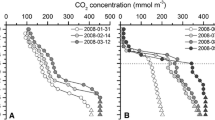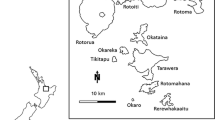Abstract
The concentrations of organic carbon (OC) and CaCO3 in lake sediments are often inversely related. This relation occurs in surface sediments from different locations in the same lake, surface sediments from different lakes, and with depth in Holocene sediments. Where data on accumulation rates are available, the relation holds for organic carbon and CaCO3 accumulation rates as well. An increase of several percent OC is accompanied by a decrease of several tens of percent CaCO3 indicating that the inverse relation is not due to simple dilution of one component by another. It appears from core data that once the OC concentration in the sediments becomes greater than about 12%, the CO2 produced by decomposition of that OC and production of organic acids lowers the pH of anoxic pore waters enough to dissolve any CaCO3 that reaches the sediment-water interface. In a lake with a seasonally anoxic hypolimnion, processes in the water column also can produce an inverse relation between OC and CaCO3 over time. If productivity of the lake increases, the rain rate of OC from the epilimnion increases. Biogenic removal of CO2 and accompanying increase in pH also may increase the production of CaCO3. However, the decomposition of organic matter in the hypolimnion will decrease the pH of the hypolimnion causing greater dissolution of CaCO3 and therefore a decrease in the rain rate of CaCO3 to the sediment-water interface.
Similar content being viewed by others
References
Anderson, R. Y., 1993. The varve chronometer in Elk Lake sediments: Record of climatic variability and evidence for solar/geomagnetic 14C-climate connection. Coring, sampling, and time-series construction. In Bradbury J. P. & W. E. Dean (eds.). Elk Lake, Minnesota: Evidence for Rapid Climate Change in the North-Central United States. Geol. Soc. Am. Spec. Paper 276: 45-68.
Anderson, R. Y., J. P. Bradbury, W. E. Dean & M. Stuiver, 1993. Chronology of Elk Lake sediments: Coring, sampling, and time-series construction. In Bradbury J. P. and W. E. Dean (eds.). Elk Lake, Minnesota: Evidence for Rapid Climate Change in the North-Central United States. Geol. Soc. Am. Spec. Paper 276: 37-44.
Averett, R. C. & T. C. Winter, 1997. History and status of the U.S. Geological Survey Interdisciplinary Research Initiative in the Shingobee River heradwaters area. In Winter T. C. (ed.), Interdisciplinary Research Initiative: Hydrological and Biogeochemical Research in the Shingobee River Headwaters Area, North-Central Minnesota, USGS Water Resources Investigations Research 96-4215: 1-2.
Bradbury, J. P., 1975. Diatom Stratigraphy and human settlement in Minnesota. Geol. Soc. Am. Spec. Paper 171, 74pp.
Dean, W. E., 1974. Determination of carbonate and organic matter in calcareous sediments and sedimentary rocks by loss on ignition: Comparison with other methods. J. Sediment. Petrol. 44: 242-248.
Dean, W. E., 1981. Carbonate minerals and organic matter in sediments of modern north temperate hard-water lakes. In Ethridge F. & R. Flores (eds.). Recent and Ancient Nonmarine Depositional Environments: Models for Exploration. Soc. Econ. Mineral. Paleontol. Spec. Publ. 32: 213-231.
Dean, W. E., 1993. Physical properties, mineralogy, and geochemistry of Holocene varved sediments from Elk Lake, Minnesota. In Bradbury J. P. & W. E. Dean (eds.),.Elk Lake, Minnesota: Evidence for Rapid Climate Change in the North-Central United States. Geol. Soc. Am. Spec. Paper 276: 135-157.
Dean, W. E. & J. P. Bradbury, 1997, Transects of organic carbon, calcium carbonate, and diatoms in surface sediments of Williams and Shingobee Lakes, In Winter T. C. (ed.). Interdisciplinary Research Initiative: Hydrological and Biogeochemical Research in the Shingobee River Headwaters Area, North-Central Minnesota, U. S. Geological Survey, Water Resources Investigations Research 96-4215: 117-129.
Dean, W. E. & E. Gorham, 1976. Major chemical and mineral components of profundal sediments in Minnesota lakes. Limnol. Oceanogr. 21: 259-284.
Dean, W. E. & R. O. Megard, 1993. Environment of deposition of CaCO3 in Elk Lake, Minnesota. In Bradbury J. P. and W. E. Dean (eds.). Elk Lake, Minnesota: Evidence for Rapid Climate Change in the North-Central United States. Geol. Soc. Am. Spec. Paper 276: 97-114.
Dean, W. E. & A. Schwalb, 1997. Carbonate, organic carbon, and isotope evidence for progressive closing of a Minnesota lake during the early Holocene. EOS (Trans. Am. Geophys. Union), 78: F301.
Dean, W. E. E. Gorham & D. J. Swaine, 1988. Geochemistry of surface sediments of lakes in the English Lake District. In Round F. E. (ed.). Algae and the Aquatic Environment. Biopress, 244-271.
Dean, W. E., E. Gorham & D. J. Swaine, 1993. Geochemistry of surface sediments of Minnesota lakes. In Bradbury J. P. and W. E. Dean (eds.). Elk Lake, Minnesota: Evidence for Rapid Climate Change in the North-Central United States. Geol. Soc. Am. Spec. Paper 276: 115-133.
Dean, W. E., J. P. Bradbury, R. Y. Anderson, L. R. Bader & K. Dieterich-Rurup, 1994. A high-resolution record of climatic change in Elk Lake, Minnesota for the last 1500 years. USGS Open-File Rept. 94-578, 127 p.
Englemann, E. E., L. L. Jackson, D. R. Norton & A. G. Fischer, 1985. Determination of carbonate carbon in geological materials by coulometric titration. Chem. Geol. 53: 125-128.
Gorham, E. & J. E. Sanger, 1975. Fossil pigments in Minnesota lake sediments and their bearing upon the balance between terrestrial and aquatic inputs to sedimentary organic matter. Verhang. Internat. Verein. Limnol., 19: 2267-2273.
Gorham, E., W. E. Dean & J. E. Sanger, 1982. The chemical composition of lakes in the north-central United States. U. S. Geological Survey Open-File Report 82-149.
Gorham, E., W. E. Dean & J. E. Sanger, 1983. The chemical composition of lakes in the north-central United States. Limnol. Oceanogr., 28: 287-301.
Gorham, E., J. W. G. Lund, J. E. Sanger, J.E. & W. E. Dean, 1974. Some relationships between algal standing crop, water chemistry, and sediment chemistry in the English lakes. Limnol. Oceanogr., 19: 601-617.
Hansen, K., 1959. The terms Gyttja and Dy. Hydrobiol., 13: 309-315.
Hansen, H. L., V. Kurmis & D. D. Ness, 1974. The ecology of upland forest communities and implications for management in Itasca State Park, Minnesota. Univ. Minnesota, Agricultural Experiment Station, Technical Bull. 298, Forestry Series 16, 43pp.
LaBaugh, J. W., D. O. Rosenberry & T. C. Winter, 1995. Groundwater contributions to the water and chemical budgets of Williams Lake, Minnesota, 1980-1991. Can. J. Fish. Aquat. Sci. 52: 754-767.
LaBaugh, J. W., 1997. Chemical fluxes between Williams and Shingobee Lakes and their watersheds. In Winter T. C. (ed.). Interdisciplinary Research Initiative: Hydrological and Biogeochemical Research in the Shingobee River Headwaters Area, North-Central Minnesota, U. S. Geological Survey, Water Resources Investigations Research 96-4215: 55-58.
Locke, S. M., 1995. A paleohydrologic model applied to the Holocene stratigraphy of two lakes in north-central Minnesota. Doctoral Dissertation, Univ. Minnesota, 258 pp.
Locke, S. M. & A. Schwalb, 1997, Sediment stratigraphy and paleolimnological characteristics of Williams and Shingobee Lakes. In Winter T. C. (ed.). Interdisciplinary Research Initiative: Hydrological and Biogeochemical Research in the Shingobee River Headwaters Area, North-Central Minnesota, U. S. Geological Survey, Water Resources Investigations Research 96-4215: 187-192.
Megard, R. O., J. P. Bradbury & W. E. Dean, 1993. Climatic and limnologic setting of Elk Lake. In Bradbury J. P. & W. E. Dean (eds.). Elk Lake, Minnesota: Evidence for Rapid Climate Change in the North-Central United States. Geol. Soc. Am. Spec. Paper 276: 19-36.
McConnaughey, J. W. LaBaugh, D. O. Rosenberry, R. G. Striegl, M. M. Reddy P. F. Schuster, & V. Carter, 1995. Carbon budget for a groundwater-fed lake: Calcification supports summer photosynthesis. Limnol. Oceanogr. 39: 1319-1332.
McConnaughey, J. W. LaBaugh, P. F. Schuster, V. Carter, R. G. Striegl, M. M. Reddy & D. O. Rosenberry, 1997. Calcification promotes macrophyte photosynthesis in Williams Lake. In Winter T. C. (ed.). Interdisciplinary Research Initiative: Hydrological and Biogeochemical Research in the Shingobee River Headwaters Area, North-Central Minnesota, U. S. Geological Survey, Water Resources Investigations Research 96-4215: 89-92.
Meyers, P. A. & R. Ishiwatari, 1993. Lacustrine organic geochemistry-an overview of indicators of organic matter sources and diagenesis in lake sediments. Org. Geochem. 20: 867-900.
Nuhfer, E. B., R. Y. Anderson, J. P. Bradbury & W. E. Dean, 1993. Modern sedimentation in Elk Lake, Clearwater County, Minnesota. In Bradbury J. P. & W. E. Dean (eds.). Elk Lake, Minnesota: Evidence for Rapid Climate Change in the North-Central United States. Geol. Soc. Am. Spec. Paper 276: 75-96.
Sanger, J.E. & E. Gorham, 1970. The diversity of pigments in lake sediments and its ecological significance. Limnol. Oceanogr. 15: 59-69.
Schwalb, A., S. M. Locke & W. E. Dean, 1995. Ostracode %#x03B4;18O and %#x03B4;13C evidence of Holocene environmental changes in the sediments of two Minnesota Lakes. J. Paleolim. 14: 281-296.
Webb, R. S. & T. Webb III, 1988. Rates of sediment accumulation in pollen cores from small lakes and mires of eastern North America. Quat. Res., 30: 284-297.
Wetzel, R. G., 1975. Limnology. Saunders, 743 pp.
Whitlock, C., P. J. Bartlein & W. A. Watts, 1993, Vegetation history of Elk Lake. In Bradbury J. P. & W. E. Dean (eds.). Elk Lake, Minnesota: Evidence for Rapid Climate Change in the Northcentral United States. Geol. Soc. Am. Spec. Paper 276: 251-274.
Author information
Authors and Affiliations
Rights and permissions
About this article
Cite this article
Dean, W.E. The carbon cycle and biogeochemical dynamics in lake sediments. Journal of Paleolimnology 21, 375–393 (1999). https://doi.org/10.1023/A:1008066118210
Issue Date:
DOI: https://doi.org/10.1023/A:1008066118210




